
|
In the cleaning nozzle, the water flow is deflected and distributed over the individual nozzle apertures and inserts. Image 3‑41 indicates how three different cleaning nozzles deflect water jets differently. The latter are significantly determined by both the form and design of the nozzle, and hence the flow conditions prevailing there. (Table: Different water jet deflections and their effect on the efficiency of the radial nozzle) In addition to the … |

|
|
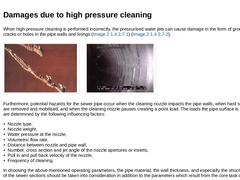
|
When high pressure cleaning is performed incorrectly, the pressurised water jets can cause damage in the form of grooves, flakes, cracks or holes in the pipe walls and linings (Image 3‑42) (Image 3‑43). (Image: Verified clay pipe damage as a result of the incorrect use of HP cleaning) (Image: HP cleaning damage) Furthermore, potential hazards for the sewer pipe occur when the cleaning nozzle impacts the pipe walls, when hard solid deposits are removed … |
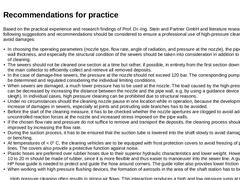
|
Based on the practical experience and research findings of Prof. Dr.-Ing. Stein and Partner GmbH and literature research, the following suggestions and recommendations should be considered to ensure a professional use of high-pressure cleaning in order to avoid damages: -
In choosing the operating parameters (nozzle type, flow rate, angle of radiation, and pressure at the nozzle), the pipe material, the wall thickness, and especially the structural …
|

|
|
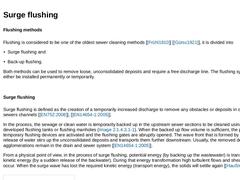
|
Flushing methods Flushing is considered to be one of the oldest sewer cleaning methods [ [Frühl1910]] [ [Gürsc1921]], it is divided into -
Surge flushing and
-
Back-up flushing.
Both methods can be used to remove loose, unconsolidated deposits and require a free discharge line. The flushing systems can either be installed permanently or temporarily. Surge flushing Surge flushing is defined as the creation of a temporarily increased discharge to remove … |

|
Currently, there are several different surge flushing devices used for surge flushing of drains and sewers as well as local drainage structures. According to [ [Dettm2004a]], these devices are categorised into four groups with respect to their structure and technical equipment (Image 3‑47): -
Wastwater volume activated flushing system,
-
Flushing using a tipping bucket,
-
Flushing using a flushing chamber and
-
Surge manhole flushing system.
(Table: Schematic … |
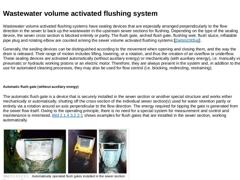
|
Wastewater volume activated flushing systems have sealing devices that are especially arranged perpendicularly to the flow direction in the sewer to back up the wastewater in the upstream sewer sections for flushing. Depending on the type of the sealing device, the sewer cross section is blocked entirely or partly. The flush gate, arched flush gate, flushing weir, flush sluice, inflatable pipe plug and rotating elbow are counted among the sewer volume … |

|
Flushing systems with a tipping bucket serve for the automatic cleaning of stormwater storage basins (e.g. stormwater sewer, stormwater overflow basin, etc.). The flushing water is stored in a comparatively small flushing tank in the form of a tipping bucket or pivoting drum and released abruptly. The emptying of the flushing tank is automatically triggered by a shift in its centre of gravity as it reaches the maximum filling level. An example of … |

|
Flushing systems using a flushing chamber serve to clean stormwater sewers and stormwater tanks. The flushing chamber is an additionally arranged structure to take in and back up the flushing water. Depending on the type of the sealing device, a distinction is made between the: -
Vacuum operated flushing chamber and
-
Flushing chamber with a flush gate
The structure and operating principle of a vacuum operated flushing chamber of the type “Biogest-System“ … |
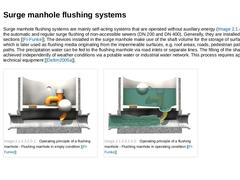
|
Surge manhole flushing systems are mainly self-acting systems that are operated without auxiliary energy (Image 3-72) for the automatic and regular surge flushing of non-accessible sewers (DN 200 and DN 400). Generally, they are installed in the starting sections [ [FI-Funke]]. The devices installed in the surge manhole make use of the shaft volume for the storage of surface water, which is later used as flushing media originating from the impermeable … |

|
Surge flushing is the oldest cleaning method used in sewer systems. Owing to the developments in the field of process measuring and control technology as well as telecontrol engineering, surge flushing is increasingly applied and preferably used to clean stormwater tanks and stormwater sewers. Compared to conventional high pressure cleaning ( (High Pressure Cleaning)), surge flushing is economically preferable, if the following local and limiting … |

|
|

|
Back-up flushing In the case of back-up flushing, devices are introduced into the sewer that reduce its cross section, back up the sewage and thus, increase the flow velocity. Because of this back up, i.e. the difference in the water level in front of and behind the devices, these are driven forward and the flushing water flows around them. In the process, the unconsolidated deposits are removed and transported [ [Führb1980]]. The method of back-up … |

|
According to DIN EN 14654 Part 1 [ [EN14654-1:2005]], a flushing shield is a device that is used to clean drains or sewers by increasing the flow velocity of the flushing water through the narrowing of the sewer cross section. The process involves installing into the sewer pipe a flushing shield device that is fitted to the sewer cross section. The shield is equipped with one (Image 3‑77) or more (Image 3‑78) small diameter pipes which are used to … |

|
|

|
|

|
Mechanical methods Mechanical cleaning can be carried out: -
manually with auxiliary equipment,
-
with cleaning devices,
-
or with special devices.
Manual cleaning with auxiliary equipment Manual cleaning with auxiliary equipment in non-accessible drains and sewers is carried out using, for example, rods or coils (Image 3‑84). In the process, an appropriate cleaning attachment is fixed on a flexible rod or coil which is spun and forced through the line … |
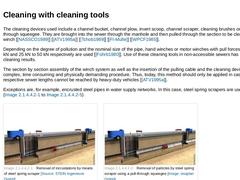
|
The cleaning devices used include a channel bucket, channel plow, invert scoop, channel scraper, cleaning brushes or a pull-through squeegee. They are brought into the sewer through the manhole and then pulled through the section to be cleaned using a winch [ [NASSCO1989]] [ [ATV1995a]] [ [Tchob1989]] [ [FI-Mülle]] [ [WPCF1985]]. Depending on the degree of pollution and the nominal size of the pipe, hand winches or motor winches with pull forces of … |
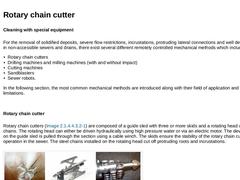
|
Cleaning with special equipment For the removal of solidified deposits, severe flow restrictions, incrustations, protruding lateral connections and well developed roots in non-accessible sewers and drains, there exist several different remotely controlled mechanical methods which include: -
Rotary chain cutters
-
Drilling machines and milling machines (with and without impact)
-
Cutting machines
-
Sandblasters
-
Sewer robots.
In the following section, the … |

|
Drilling and milling machines are remotely controlled and commonly used in conjunction with camera supervision in pipe sizes ranging from DN 200 to DN 600 to remove solidified/hard deposits, protruding connection sewers, and other obstacles and roots. They are driven hydraulically using oil or water pressure. To ensure that no pipe damage occurs, these devices are fixed in a central position. In individual cases they are also equipped with varying … |
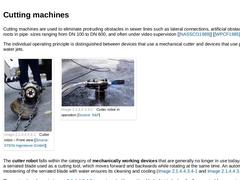
|
Cutting machines are used to eliminate protruding obstacles in sewer lines such as lateral connections, artificial obstacles as well as roots in pipe sizes ranging from DN 100 to DN 600, and often under video supervision [ [NASSCO1989]] [ [WPCF1985]]. The individual operating principle is distinguished between devices that use a mechanical cutter and devices that use pressurised water jets. (Image: Cutter robot – Front view ) (Image: Cutter robot in … |
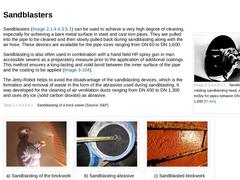
|
(Image: Sandblaster with rotating sandblasting head, and centring trolley for pipes between DN 350 and DN 1,600) Sandblasters (Image 3‑103) can be used to achieve a very high degree of cleaning, especially for achieving a bare metal surface in steel and cast iron pipes. They are pulled into the pipe to be cleaned and then slowly pulled back during sandblasting along with the air hose. These devices are available for the pipe sizes ranging from DN … |
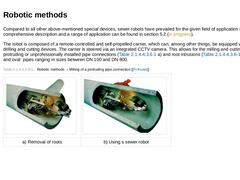
|
Compared to all other above-mentioned special devices, sewer robots have prevailed for the given field of application in practice. A comprehensive description and a range of application can be found in section 5.2 (in progress). The robot is composed of a remote-controlled and self-propelled carrier, which can, among other things, be equipped with milling, drilling and cutting devices. The carrier is steered via an integrated CCTV camera. This allows … |
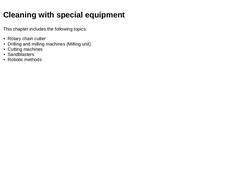
|
|